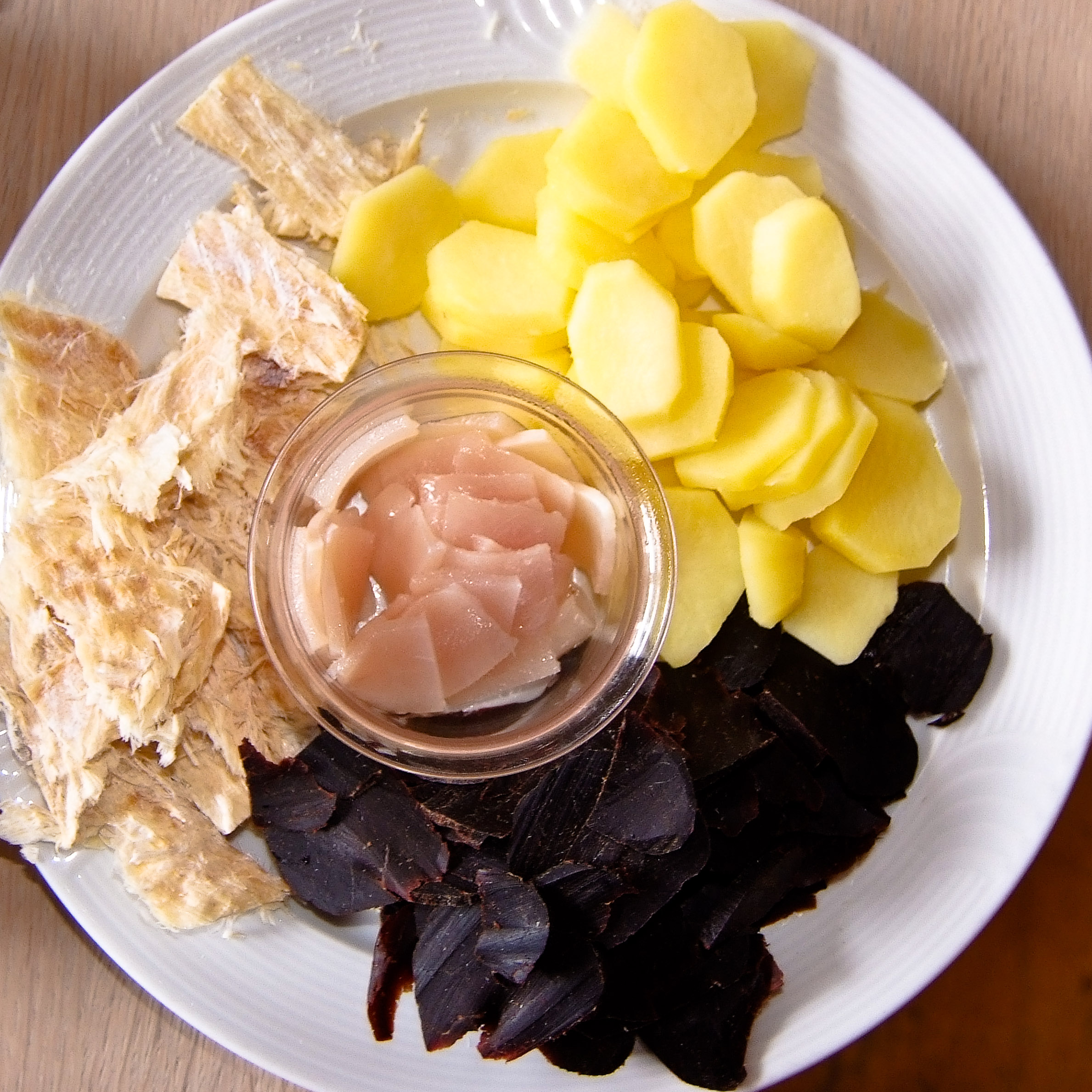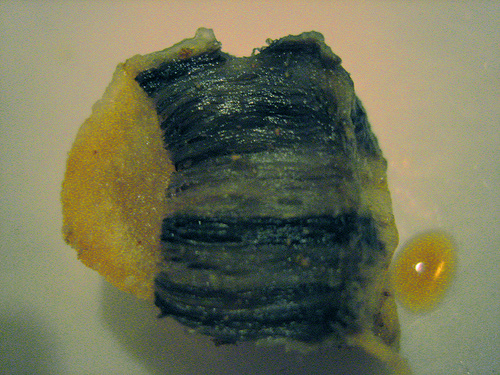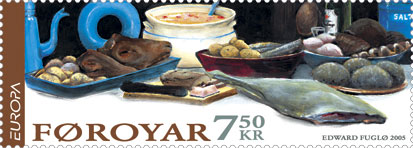|
Tvøst Og Spik
Tvøst og spik (also called ''Grind og spik'') is a typical dish of the Faroe Islands, a self-governing country of Denmark, located in the North Atlantic. ''Tvøst og spik'' consists of Pilot Whale meat, blubber and potatoes. The meat is prepared in different ways, it can be boiled or fried fresh, it can be stored in either dry salt (''turrsaltað'') or in very salty water (''lakasaltað''), it can be frozen and later prepared, or it can be hung up outdoors in order to dry. When it is hung out to dry, it is cut in long slices (''grindalikkja''), and then hung under a roof, to shield it from the rain. The blubber can also be prepared in different ways, boiled, salted or dried, but not fried. Dried blubber can also be eaten together with dried fish, as shown on the photo. The whale meat has a very dark color, almost black. The tradition of eating whale meat and blubber dates back many centuries, being first mentioned directly in the Faroese part of the Norwegian Gulating ... [...More Info...] [...Related Items...] OR: [Wikipedia] [Google] [Baidu] |
Faroe Islands
The Faroe Islands ( ), or simply the Faroes ( fo, Føroyar ; da, Færøerne ), are a North Atlantic island group and an autonomous territory of the Kingdom of Denmark. They are located north-northwest of Scotland, and about halfway between Norway ( away) and Iceland ( away). The islands form part of the Kingdom of Denmark, along with mainland Denmark and Greenland. The islands have a total area of about with a population of 54,000 as of June 2022. The terrain is rugged, and the subpolar oceanic climate (Cfc) is windy, wet, cloudy, and cool. Temperatures for such a northerly climate are moderated by the Gulf Stream, averaging above freezing throughout the year, and hovering around in summer and 5 °C (41 °F) in winter. The northerly latitude also results in perpetual civil twilight during summer nights and very short winter days. Between 1035 and 1814, the Faroe Islands were part of the Kingdom of Norway, which was in a personal union with Denmark from 1 ... [...More Info...] [...Related Items...] OR: [Wikipedia] [Google] [Baidu] |
Denmark
) , song = ( en, "King Christian stood by the lofty mast") , song_type = National and royal anthem , image_map = EU-Denmark.svg , map_caption = , subdivision_type = Sovereign state , subdivision_name = Danish Realm, Kingdom of Denmark , established_title = History of Denmark#Middle ages, Consolidation , established_date = 8th century , established_title2 = Christianization , established_date2 = 965 , established_title3 = , established_date3 = 5 June 1849 , established_title4 = Faroese home rule , established_date4 = 24 March 1948 , established_title5 = European Economic Community, EEC 1973 enlargement of the European Communities, accession , established_date5 = 1 January 1973 , established_title6 = Greenlandic home rule , established_date6 = 1 May 1979 , official_languages = Danish language, Danish , languages_type = Regional languages , languages_sub = yes , languages = German language, GermanGerman is recognised as a protected minority language in t ... [...More Info...] [...Related Items...] OR: [Wikipedia] [Google] [Baidu] |
Pilot Whale
Pilot whales are cetaceans belonging to the genus ''Globicephala''. The two extant species are the long-finned pilot whale (''G. melas'') and the short-finned pilot whale (''G. macrorhynchus''). The two are not readily distinguishable at sea, and analysis of the skulls is the best way to distinguish between the species. Between the two species, they range nearly worldwide, with long-finned pilot whales living in colder waters and short-finned pilot whales living in tropical and subtropical waters. Pilot whales are among the largest of the oceanic dolphins, exceeded in size only by the orca. They and other large members of the dolphin family are also known as blackfish. Pilot whales feed primarily on squid, but will also hunt large demersal fish such as cod and turbot. They are highly social and may remain with their birth pod throughout their lifetime. Short-finned pilot whales are one of the few mammal species in which females go through menopause, and postreproductive females ... [...More Info...] [...Related Items...] OR: [Wikipedia] [Google] [Baidu] |
Whale Meat
Whale meat, broadly speaking, may include all cetaceans (whales, dolphins, porpoises) and all parts of the animal: muscle (meat), organs (offal), skin (muktuk), and fat (blubber). There is relatively little demand for whale meat, compared to farmed livestock. Commercial whaling, which has faced opposition for decades, continues today in very few countries (mainly Iceland, Japan and Norway), despite whale meat being eaten across Western Europe and colonial America previously. However, in areas where dolphin drive hunting and aboriginal whaling exist, marine mammals are eaten locally as part of a subsistence economy: the Faroe Islands, the circumpolar Arctic (the Inuit in Canada and Greenland, related peoples in Alaska, the Chukchi people of Siberia), other indigenous peoples of the United States (including the Makah people of the Pacific Northwest), St. Vincent and the Grenadines (mainly on the island of Bequia), some of villages in Indonesia and in certain South Pacific islan ... [...More Info...] [...Related Items...] OR: [Wikipedia] [Google] [Baidu] |
Blubber
Blubber is a thick layer of vascularized adipose tissue under the skin of all cetaceans, pinnipeds, penguins, and sirenians. Description Lipid-rich, collagen fiber-laced blubber comprises the hypodermis and covers the whole body, except for parts of the appendages. It is strongly attached to the musculature and skeleton by highly organized, fan-shaped networks of tendons and ligaments, can comprise up to 50% of the body mass of some marine mammals during some points in their lives, and can range from thick in dolphins and smaller whales, to more than thick in some bigger whales, such as right and bowhead whales. However, this is not indicative of larger whales' ability to retain heat better, as the thickness of a whale's blubber does not significantly affect heat loss. More indicative of a whale's ability to retain heat is the water and lipid concentration in blubber, as water reduces heat-retaining capacities, and lipid increases them. Function Blubber is the primary fat st ... [...More Info...] [...Related Items...] OR: [Wikipedia] [Google] [Baidu] |
Gulating
Gulating ( non, Gulaþing) was one of the first Norwegian legislative assemblies, or '' things,'' and also the name of a present-day law court of western Norway. The practice of periodic regional assemblies predates recorded history, and was firmly established at the time of the unification of Norway into a single kingdom (900–1030). These assemblies or ''lagþings'' were not democratic, but did not merely serve elites either. They functioned as judicial and legislative bodies, resolving disputes and establishing laws. Gulaþing, along with Norway's three other ancient regional assemblies, the Borgarting, Eidsivating, and Frostating, were joined into a single jurisdiction during the late 13th century, when King Magnus the Lawmender had the existing body of law put into writing (1263–1280). They provided the institutional and legal framework for subsequent legislative and judicial bodies, and remain in operation today as superior regional courts. History The Gulaþing was a ... [...More Info...] [...Related Items...] OR: [Wikipedia] [Google] [Baidu] |
Faroese Cuisine
Important parts of Faroese cuisine are lamb and also fish owing to proximity to the sea. Traditional foods from the Faroe Islands include skerpikjøt (a type of dried mutton), seafood, whale meat, blubber, garnatálg, Faroese puffins, potatoes, and few fresh vegetables. Much of the taste of this traditional country food is determined by the food preservation methods used; brine, drying, and the maturing of meat and fish, called ''ræstkjøt'' and ''ræstur fiskur''. Animal products dominate Faroese cuisine. Popular taste has developed, however, to become closer to the European norm, and consumption of vegetables has greatly increased in recent decades while consumption of fish has diminished. Fresh and ''ræst'' lamb meat remains very popular while traditional meat products, such as various types of sausages, have lost much of their appeal with younger generations. Types of food Fish Fish dishes in the Faroe Islands are caught in the waters of the North Atlantic Oce ... [...More Info...] [...Related Items...] OR: [Wikipedia] [Google] [Baidu] |
Whale Dishes
Whales are a widely distributed and diverse group of fully aquatic placental marine mammals. As an informal and colloquial grouping, they correspond to large members of the infraorder Cetacea, i.e. all cetaceans apart from dolphins and porpoises. Dolphins and porpoises may be considered whales from a formal, cladistic perspective. Whales, dolphins and porpoises belong to the order Cetartiodactyla, which consists of even-toed ungulates. Their closest non-cetacean living relatives are the hippopotamuses, from which they and other cetaceans diverged about 54 million years ago. The two parvorders of whales, baleen whales (Mysticeti) and toothed whales (Odontoceti), are thought to have had their last common ancestor around 34 million years ago. Mysticetes include four extant (living) families: Balaenopteridae (the rorquals), Balaenidae (right whales), Cetotheriidae (the pygmy right whale), and Eschrichtiidae (the grey whale). Odontocetes include the Monodontidae (belugas and n ... [...More Info...] [...Related Items...] OR: [Wikipedia] [Google] [Baidu] |




